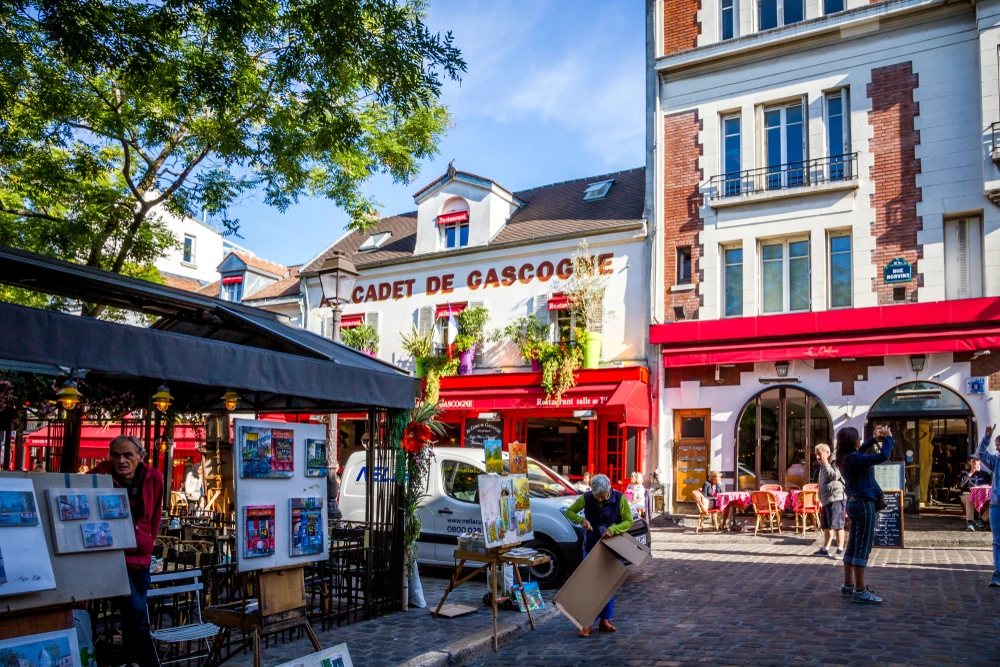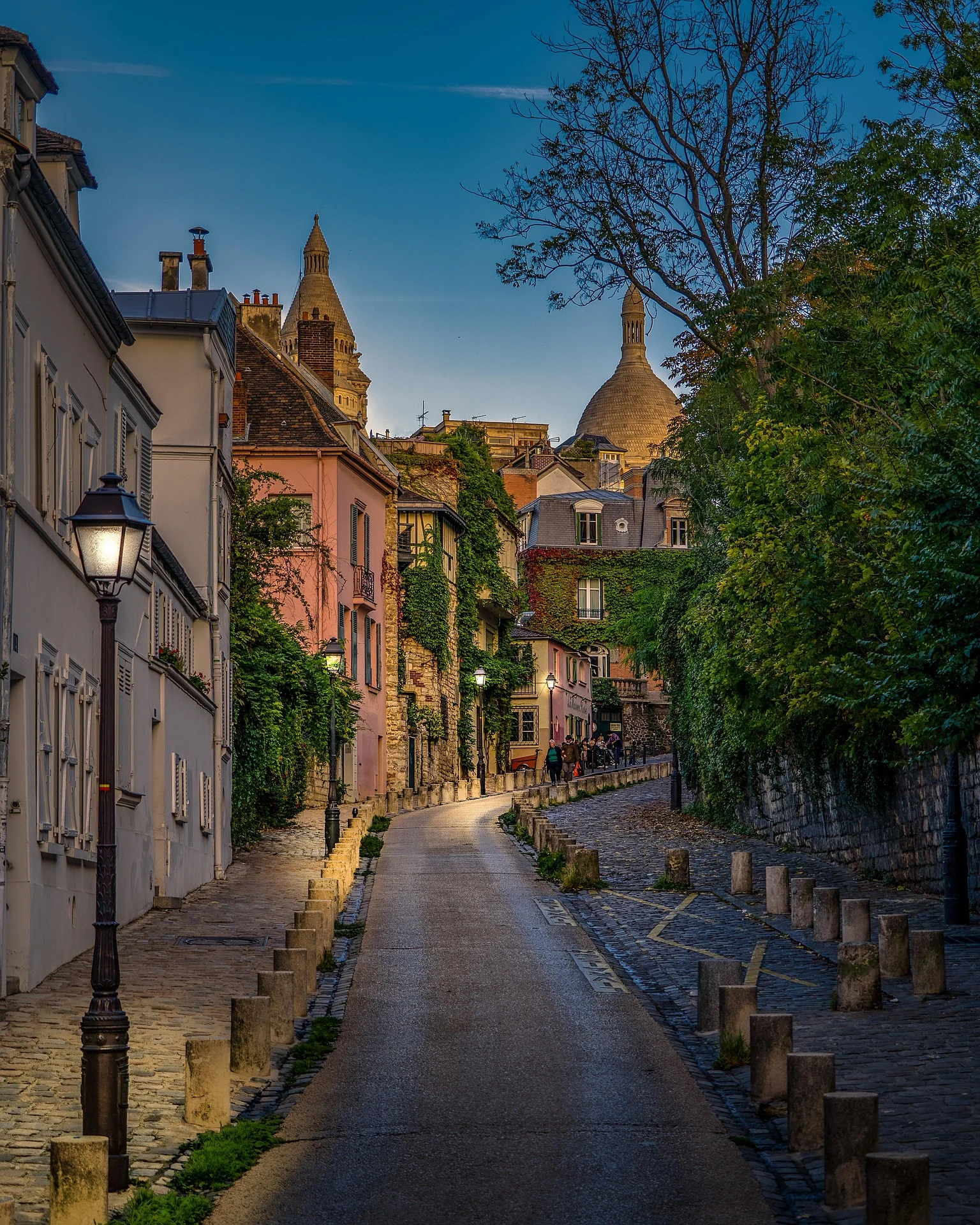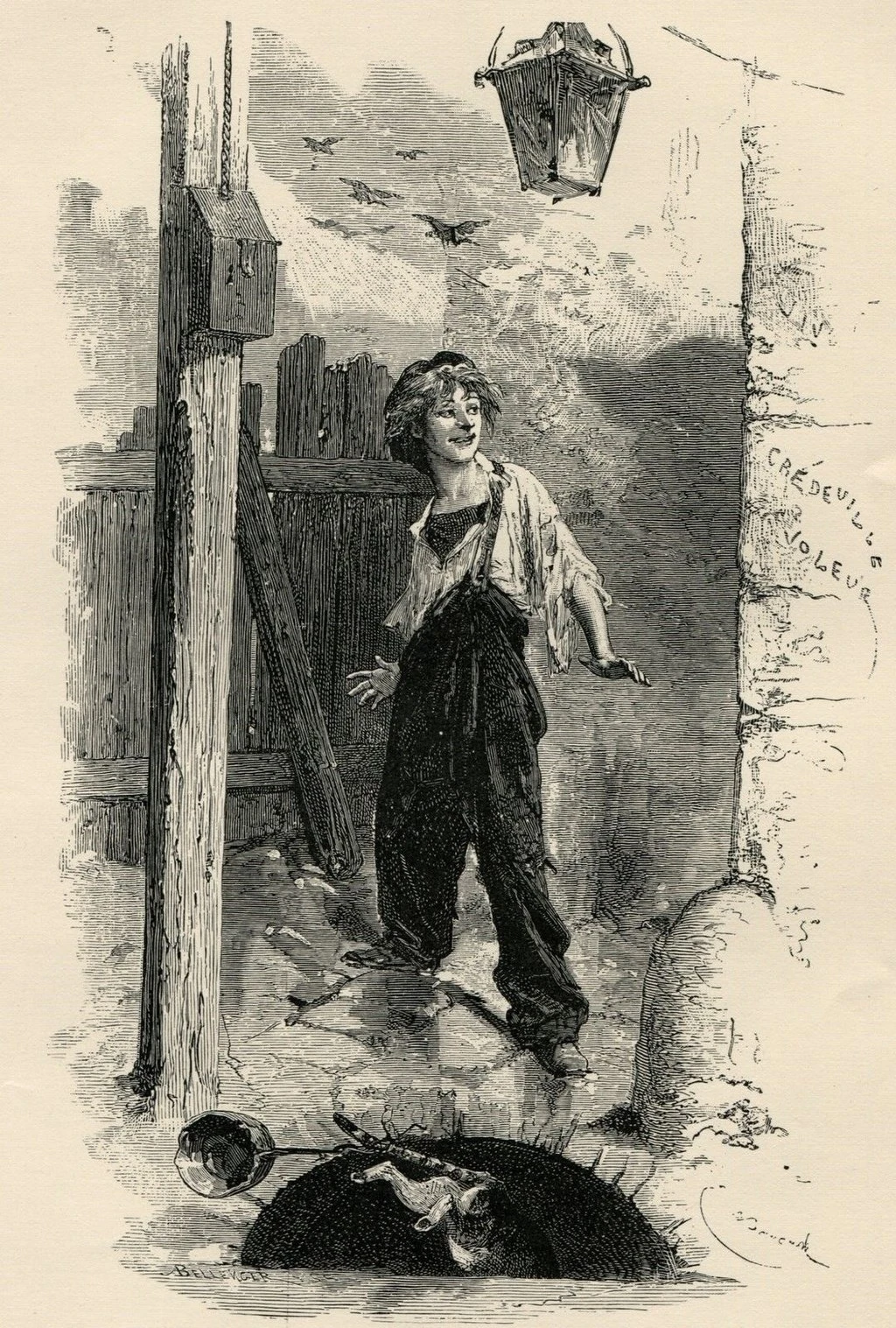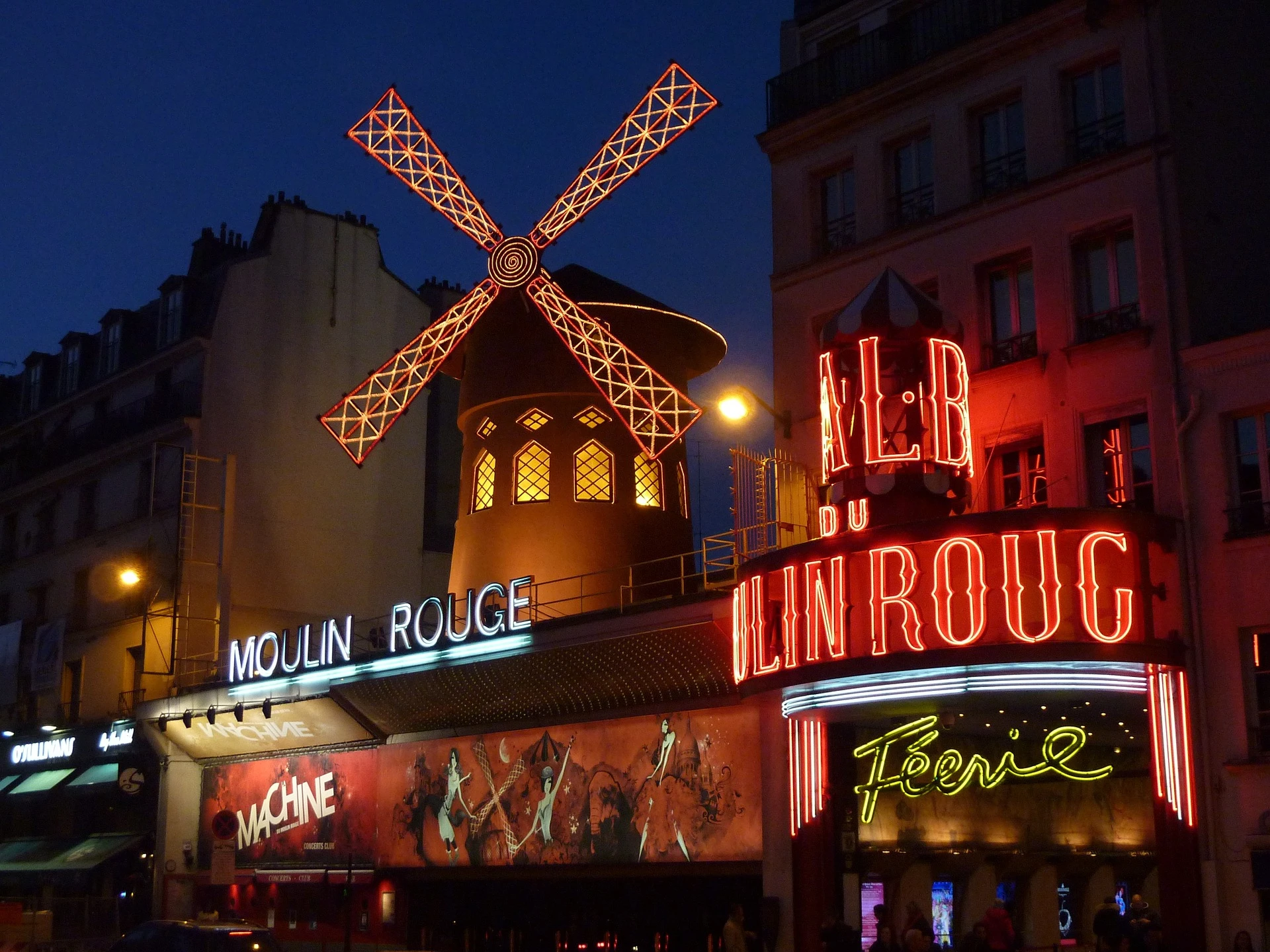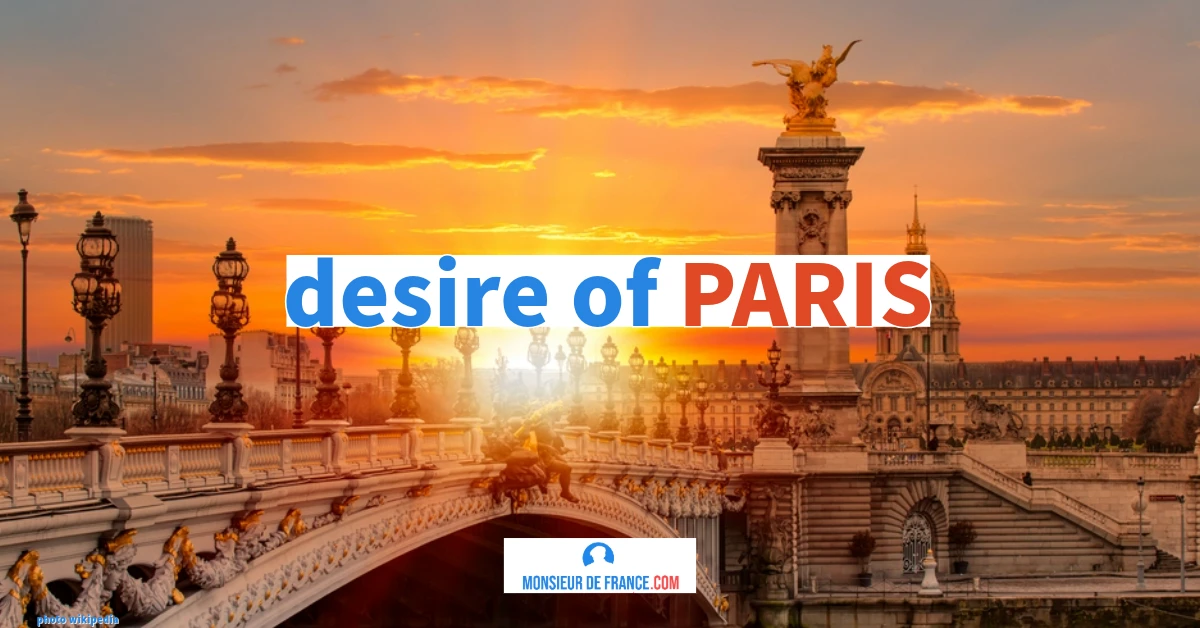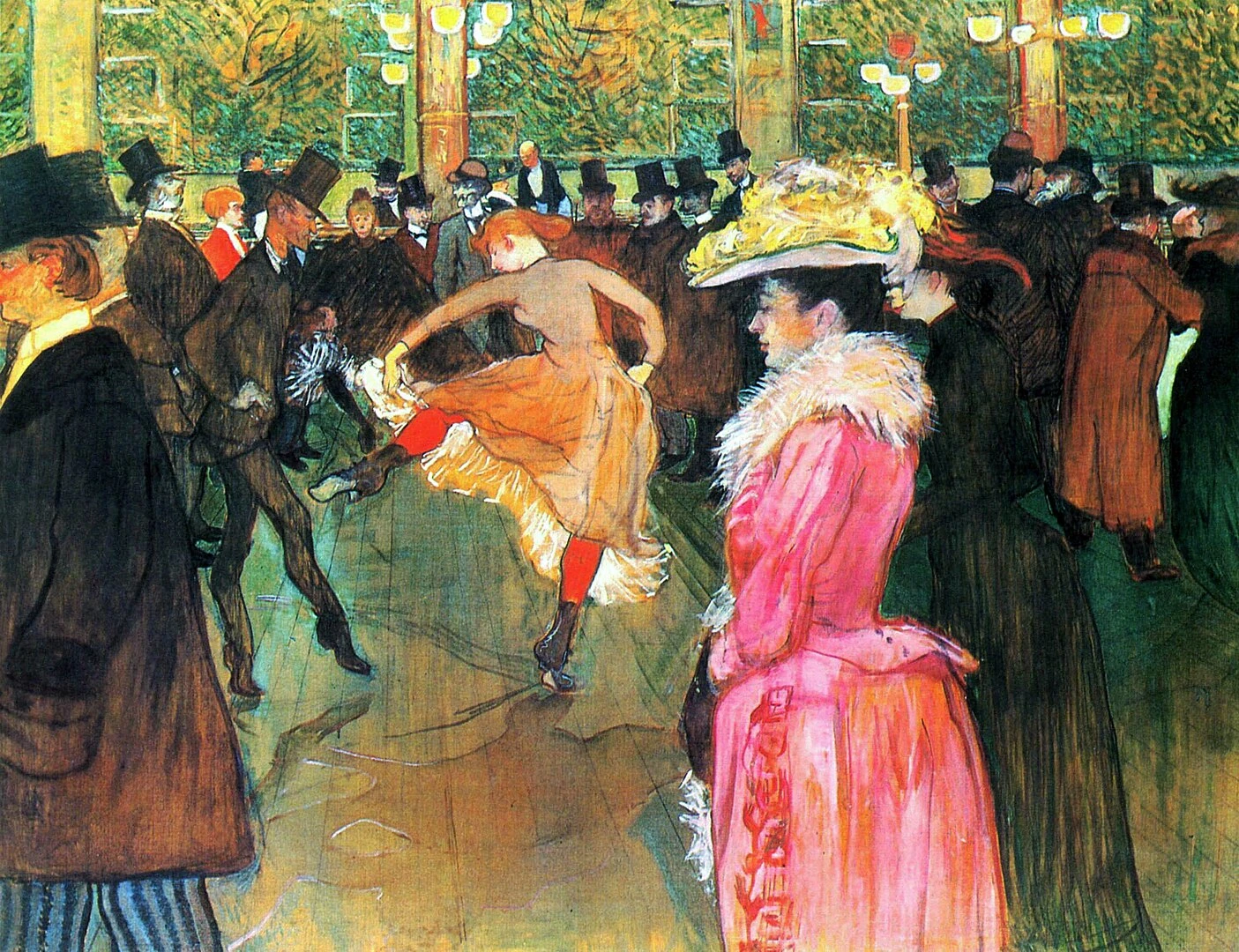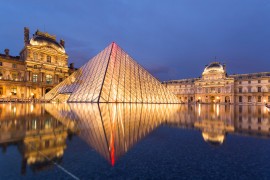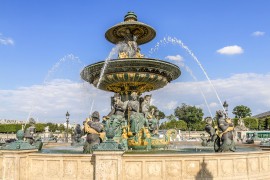Here is a summary of what you will discover:
You will learn what makes Montmartre so unique and why it has attracted artists and dreamers for over a century.
I will guide you to the must-see places, but also to the most secret ones.
You will find a recommended itinerary for visiting Montmartre on foot. Finally, you will get practical information, anecdotes, and tips for avoiding the crowds and enjoying this timeless neighborhood to the fullest.
Montmartre: the bohemian soul of Paris
It is the highest point in Paris. 130 meters above sea level. It is not that easy to climb Montmartre, proof that it is quite high. 222 steps if you take the stairs on Rue Foyatier. It's less tiring if you take the funicular and enjoy a beautiful view of Paris. Put into service in 1900, it can carry 1,300 people per hour per track. It used to run on water before switching to electricity. The lower station is located at Place Saint Pierre and Place Suzanne Valadon. The upper station is located at Place du Cardinal Dubois. A ticket for the Montmartre funicular costs the same as a Paris metro ticket, i.e., €1.90 in 2023.
Sacré-Cœur Basilica: symbol of Montmartre
Sacré-Cœur Basilica in Montmartre. Photo selected by Monsieurdefrance.com: Shutterstock.com
It is relatively recent in the history of Paris, having been opened in 1875, inaugurated in 1895, and completed in 1923. It was also recently classified as a Historic Monument (2022). Standing 85 meters high at the top of the highest of the five domes (added to the 130 meters of the hill, which means that this monument can be seen from far away in Paris), it was built after the debacle of 1871 with the consent of the National Assembly, which authorized its construction (at the time, the Church and the State were not yet separate) so that Catholic worship could be celebrated there. In reality, it was built by conservatives in response to the Paris Commune, on the very site where this revolution began. The national subscription that enabled its construction mobilized more than 10 million donors. Controversial from the moment it was built, it was almost stopped, becoming a theater and a house of the people before being completed and definitively consecrated for Catholic worship. The interior is quite dark. There are many statues to discover. The "cul de four," the back of the basilica, is quite spectacular with a mosaic representation of Christ (it is the largest mosaic in France). Admission is free, which is rare in Paris, so don't miss out.
Its bell tower, next to the Basilica, rings out the largest bell in France. Named "La Savoyarde," it was cast in Annecy in 1895, measures three meters in diameter, and weighs 18,835 kg. Every year, more than 11 million tourists (as well as pilgrims) visit Sacré-Coeur. It is the second most visited religious monument in Paris after Notre-Dame.
At the foot of Sacré-Cœur / Photo selected by Monsieur de France: by Leonhard Niederwimmer from Pixabay
Montmartre for lovers: a romantic stroll on the hill
Montmartre is undoubtedly one of the most romantic places in Paris. When the sun goes down, the neighborhood empties and regains its former charm. You can stroll hand in hand along Rue de l'Abreuvoir, sit on a bench facing Sacré-Cœur to watch Paris light up, or pass by the discreet Place Dalida, a true haven of tranquility. Montmartre at night no longer belongs to tourists, but to lovers and dreamers. It feels like you're far from Paris, almost in an Italian village, with the added charm of Parisian poetry.
And for the perfect romantic photo in Montmartre:
-
Rue de l’Abreuvoir (75018 Paris) – This is one of the most poetic streets in Paris, with the Maison Rose in the background. An ultra-Instagrammable photo, ideal at sunset.
-
Place Dalida (Rue de l'Abreuvoir / Rue Girardon, 75018) – A peaceful square surrounded by greenery, very quiet. Ideal for a tender photo, without crowds around.
-
In front of the Sacré-Cœur, north side (35 rue du Chevalier-de-la-Barre, 75018) – Less crowded than the square in front, this is an intimate spot with the white dome in the background.
The Wall of "I Love You": Love Written in 250 Languages
The "I Love You" Wall dates back to 2000 and has become a real Parisian tourist attraction / Photo selected by monsieurdefrance.com: depositphotos.
At the bottom of the hill, there is a place that melts everyone's hearts: the "I Love You" Wall, on Place Jehan-Rictus, right next to the Abbesses metro station. It is an astonishing work of art: 612 blue enameled tiles, on which "I love you" has been written in more than 250 languages, from French to Basque, Japanese to Wolof, including the cherished Lorraine phrase "Ich hab dich gär." It is impossible to walk by without smiling: there are couples embracing, shy lovers, slightly awkward but sincere selfies, knowing glances... It's a little theater of Parisian romance. It is said that several marriage proposals have been made there, discreetly, on bended knee, in front of this wall dedicated to universal love. It is one of the most romantic places in Montmartre, perfect after watching the sunset at Sacré-Cœur, or before sharing a glass of wine in a small street on the hill.
Address: 📍 Place des Abbesses, Paris 18th arrondissement — Abbesses subway station.
Place du Tertre: artistic and historical heart
Place du Tertre in Montmartre with its painters and cafés. Photo selected by monsieurdefrance.com: Daboost / Shutterstock.com
The heart of Montmartre is the Place du Tertre, which takes its name from the mound that formed the summit of Montmartre hill before the basilica was built. The site of a gallows in the Middle Ages, the planting of a Tree of Liberty during the Revolution of 1848, the storage of Paris' cannons in 1871, and the starting point of the Commune that same year, it is small (35 meters by 38) and home to many painters and caricaturists. It is surrounded by small cafés. Take Rue Mont Cenis, Rue Norvins, Rue Bonne Franquette, and Avenue Junot with its bourgeois houses, Rue des Saules is the street of the "Lapin agile" (named after a rabbit that drank), named after André Gill (the rabbit at Gill's became the agile rabbit), a famous artist who designed the sign in 1880. Léo Ferré and Claude Nougaro have performed on stage there. Montmartre is also home to the Moulin de la Galette at the corner of Rue Lepic, the Chat Noir, and the famous Moulin Rouge (we'll come back to that later).
Secret Montmartre: streets off the beaten track
To discover the authentic Montmartre, simply walk a few dozen meters away from the crowds. Rue Saint-Rustique, the oldest street on the hill, seems unchanged since the 18th century. Rue de l'Abreuvoir is one of the most charming streets in the neighborhood, especially in the morning when it is quiet. Place Marcel-Aymé and its statue of the man who could walk through walls pay tribute to a local literary figure. Further on, Rue Lamarck-Caulaincourt offers a glimpse of the real Montmartre, with its neighborhood shops. This discreet Montmartre is the one that the locals keep to themselves—the real Montmartre.
Delicious Secret Montmartre / image chosen by Monsieur de France: by Pierre Blaché from Pixabay
The streets that remember the children of Paris
At 6 rue Cortot, Erick Satie composed some of his famous pieces in 1890. Number 12 was home to Renoir and Francisque Poulbot (1879-1946), the famous artist who drew pictures of Parisian children, known as "Poulbots"—the cheeky kids who were such a familiar sight in Paris in days gone by.
Gathered in gangs, they ran riot in the streets. They were hired for next to nothing to deliver messages (they were nicknamed vas-y-dire, or "go-betweens") or to look after horses. The most famous poulbot—even though the word Poulbot was coined nearly 50 years later with the career of the illustrator Poulbot—is Gavroche, who appears in Victor Hugo's Les Misérables in 1862:
Gavroche depicted in the 19th century
"This little being is joyful. He doesn't eat every day and goes to the theater every night, if he feels like it. He has no shirt on his back, no shoes on his feet, no roof over his head; he is like the flies in the sky, which have none of these things. He is between seven and thirteen years old, lives in gangs, roams the streets, sleeps outdoors, wears his father's old pants that hang below his heels, another father's old hat that hangs below his ears, a single yellow-edged suspenders, runs, watches, begs, wastes time, (...) and has nothing bad in his heart. For he has a pearl in his soul, innocence, and pearls do not dissolve in the mud. As long as man is a child, God wants him to be innocent. If we asked the big, huge city: What is that? it would reply: That's my little one." It was for these kids of Paris, who roamed Montmartre, a working-class neighborhood that he depicted so often and loved so much, that Monsieur Poulbot opened a dispensary in 1923.
Montmartre Cemetery: Famous Artists and Destinies
It covers 11 hectares. It is the third largest cemetery in Paris. Many famous people are buried in this cemetery, including the singer Dalida (1933-1987), whose grave is regularly decorated with flowers, and Michel Berger (1947-1992). You can also see the grave of "Zdar" from the group Cassius, the cenotaph of Emile Zola (his ashes having been transferred to the Pantheon), the graves of the painter Edgar Degas, the musician Hector Berlioz, Sacha Guitry, Georges Feydau (the famous playwright), Téophile Gautier, and the vault of the Sanson family, a dynasty of executioners who played a role in the judicial history of Paris in the 17th and 18th centuries. The most famous, Charles Henri Sanson, carried out executions by guillotine during the French Revolution. His son died in an accident at work, slipping on blood on the scaffold and falling to his death. The last member of the dynasty was fired because he was a gambler, lost a lot of money, and ended up pawning the guillotine to gamble.
Le Clos Montmartre – the Parisian vineyard
The Clos de Montmartre and its 2,000 vines, at the corner of Rue des Saules and Rue Saint Vincent, produce the only wine still made in Paris (rather poor, as the vines face north, but a collector's item). Montmartre is also home to many artists, with the Maison Dali, 11 Rue Poulbot, which displays more than 300 works by the famous Catalan painter. The Halle Saint Pierre, a former covered market built in 1868, is a place dedicated to art brut.
Moulin Rouge: legendary cabaret in Montmartre
The Moulin Rouge in Paris. Photo selected by Monsieurdefrance.com Hermann Traub from Pixabay
It is the most famous cabaret in Paris. Paris has always loved to party! It's true that the atmosphere is much more civilized today than it was 100 years ago, when people came here to get a thrill by breaking the rules, drinking, laughing, and indulging in a little sensuality by seeing an ankle, a calf, and sometimes even more, thanks to the split skirts of the cancan dancers. People have always sung and danced, especially at fairs. They sang and danced to celebrate victories and royal births, those amazing moments when barrels were tapped at crossroads and Parisians were invited to drink.
In the 18th century, when the Regency shattered the shackles of King Louis XIV's final years, people loved balls at the Opera. They had a blast at masked balls, where they could seduce whomever they wanted without worrying about the social status of their desired partner. This was the great strength of Paris at the time, a large city that allowed anonymity and whose rebellious side was indulgent towards pleasure. The 19th century saw the birth of cabarets, where people sang, often against the authorities. At the end of the century, people began to dance on stage. Maupassant, Michelet, and other great male talents came to slum it, watching the young Parisian girls dance, particularly in the Montmartre area. Others lived their lives there, such as Toulouse Lautrec, who painted everyday life at the Moulin Rouge while admiring this new dance that shocked the bourgeoisie: the famous cancan. This dance was launched by Céleste Mogador at the Bal Mabille and successfully taken up by La Goulue (so nicknamed because she drank her customers' drinks) and her colleagues at the Moulin Rouge to the tunes of Offenbach. I'll take you on a tour of the Moulin Rouge here.
How to Visit Montmartre in One Day (Walking Itinerary)
The best way to visit Montmartre is on foot, following a simple loop that avoids steep climbs.
Start at Abbesses metro station, walk up Rue des Abbesses toward the Wall of Love, then continue to Place des Abbesses. From there, head to Rue Lepic and the Moulin de la Galette, before reaching Place du Tertre. End your walk at the Sacré-Cœur Basilica, where the view over Paris is unforgettable. This itinerary takes 2.5 to 3 hours, without rushing.
Best Viewpoints and Photo Spots in Montmartre
Montmartre offers some of the best panoramic views in Paris.
The steps in front of Sacré-Cœur are the most famous viewpoint. For quieter photo spots, go to Square Louise Michel, Rue de l’Abreuvoir, or Rue Saint-Vincent. Sunset is the best time for photos, with warm light over Paris rooftops.
How Long to Visit Montmartre and the Best Time to Go
Plan at least half a day to truly enjoy Montmartre.
Morning is ideal to avoid crowds, while late afternoon offers the best atmosphere. Weekdays are calmer than weekends, especially around Place du Tertre and Sacré-Cœur.
Is Montmartre Worth Visiting Compared to Other Paris Neighborhoods?
Yes, Montmartre offers a very different experience from central Paris.
Unlike the Latin Quarter or Le Marais, Montmartre feels more like a village, with narrow streets, viewpoints, and a slower rhythm. It is ideal for travelers looking for atmosphere, history, and iconic Parisian views rather than museums or shopping.
Best time to visit Montmartre
In the morning between 8:30 and 10:00 a.m., Montmartre is still a village. Shutters open, deliveries are made, cafés wake up. At noon and in the early afternoon, there are large crowds around Place du Tertre and Sacré-Cœur. The best time to enjoy the view of Paris is at the end of the day. In the evening, after 7:30 p.m., the neighborhood becomes peaceful again, with golden light and a very intimate atmosphere. Autumn and winter also offer an incomparable melancholic beauty.
Parisian restaurant in Montmartre / Photo selected by Monsieur de France: by Gerhard Bögner from Pixabay
Ideal itinerary for visiting Montmartre in 2–3 hours
Here is a smooth and pleasant route that allows you to see everything without getting tired and in the right order:
-
Departure from Abbesses station (one of the prettiest Art Nouveau metro stations).
-
Walk up Yvonne-le-Tac Street and discover the morning calm of the neighborhood.
-
Arrival in front of the Sacré-Cœur → breathtaking view of Paris, especially if you arrive before 10 a.m.
-
Head back down via Square Louise-Michel if you want a different view of the basilica.
-
Then cross the Place du Tertre → artists & terraces (but don't linger too long if it's crowded).
-
Take rue Norvins, a charming street with its small historic facades.
-
Continue towards rue des Saules → you will arrive at Clos de Montmartre, the secret vineyard.
-
Just opposite is the Lapin Agile → legendary cabaret frequented by Picasso, Utrillo, and Toulouse-Lautrec.
-
Then head down to Lamarck-Caulaincourt → village atmosphere, local bakeries, authentic Montmartre life.
-
End up in Antwerp or Pigalle depending on your mood—direct subway.
This route avoids the busiest streets and maximizes your discovery of authentic Montmartre.
If possible, take this tour in the morning or late afternoon, when the neighborhood is at its most poetic.
Practical tips for visiting Montmartre
-
Bring good shoes: Montmartre is hilly!
-
Be careful of pickpockets around Sacré-Cœur.
-
Never sign petitions, do not listen to anyone who comes up to you with a piece of paper or offers you bracelets.
-
Choose Lamarck-Coulaincourt for a coffee break or lunch.
-
The funicular railway can be accessed with a regular subway ticket.
-
Free admission to the basilica.
-
Ascend to the dome = fee required but exceptional view.
-
Best time for photos: early morning or sunset
Access to Sacré-Cœur and transportation
Address
The Basilica is located at 35 rue du Chevalier de la Barre, 75018 Paris. There are taxi ranks nearby. The closest parking lot is the "Anvers" parking lot, located at 41 boulevard Rochechouart, 75009 Paris.
By subway
Antwerp station (line 2) or Abbesses station (line 12).
A bus
Lines 30, 31, 80, 85
History of Montmartre
Montmartre was once a quiet rural village, outside the walls of Paris, surrounded by windmills, gardens, vineyards and farmland. Its elevation gave it space — physical and mental — and that attracted dreamers. In the late 19th and early 20th century, it became the beating heart of bohemian Paris. Cheap rooms, unheated studios, and the freedom to live without judgment drew artists from all over Europe. Picasso painted in a small studio; Modigliani arrived poor but determined; Utrillo wandered the streets with an eye for melancholy; Toulouse-Lautrec sketched the cabaret performers he adored.
Here, one could be unknown and brilliant, drunk or inspired, failing or visionary — and still belong. Montmartre was a sanctuary for creative misfits, where talent mattered more than money or status. Cafés served as salons, sidewalks became ateliers, and friendships were forged in smoke, wine, laughter and debate.
The spirit of Montmartre was rebellious but joyous — a rejection of rigid society, and an embrace of artistic liberty. Many masterpieces were created not in grand studios, but on café tables, in rented rooms, on scraps of cardboard. The famous posters of Lautrec, the fractured worlds of Picasso, the tender Paris of Utrillo — they all carry inside them a bit of Montmartre’s soul.
Even today, when you walk its narrow streets, you’re not just sightseeing: you are entering a living memory. The stones, the iron balconies, the stairways — they echo with music, footsteps, arguments, and inspiration from those who came before. Montmartre remains a place where you can still feel that freedom: to look, to imagine, to breathe, and to dream.

Illustration chosen by monsieurdefrance.com: La Goulue, a Montmartre resident, on the famous Moulin Rouge poster designed by Toulouse-Lautrec.
Unusual anecdotes about Montmartre
Montmartre isn't just a picture-postcard neighborhood, it's a theater of stories as delicious as the aroma of hot coffee on Rue Norvins. You may not know it, but the stonework of Sacré-Cœur cleans itself when it rains. No need for brooms or scaffolding: chemistry does the work. As a result, the basilica remains immaculate, even under Parisian pollution. And then there's the writer Marcel Aymé, a resident of the neighborhood, who created the famous "Passe-Muraille" (The Man Who Walked Through Walls). He set his story on Rue Norvins, and today, a statue literally emerges from a wall, as if to remind us that in this neighborhood, the line between reality and imagination is very thin.
Le Moulin rougePar Henri de Toulouse-Lautrec — The Yorck Project (2002) 10.000 Meisterwerke der Malerei (DVD-ROM), distributed by DIRECTMEDIA Publishing GmbH. ISBN : 3936122202., Domaine public, https://commons.wikimedia.org/w/index.php?curid=159594
It is also said that Toulouse-Lautrec did not always have enough money to pay for his drinks. So he did what he knew how to do: he sketched a dancer, a customer... And presto, the bill was paid. Today, these drawings are worth more than an apartment in Montmartre. As for the Lapin Agile, it wasn't just a cheerful cabaret: it was a place of rebellion, where people sometimes sang against the authorities, to the point that the police came to "sample the atmosphere" in their own way. And then there's this little gem: in 1921, a few Montmartre residents wanted to proclaim the independence of the Free Republic of Montmartre. With a mayor, a flag, and of course... an anthem. No matter what, France resisted this unlikely secession—but we never really got over the idea that it would have been delightful.
Montmartre is not a static monument; it is a neighborhood that breathes, laughs, drinks, dreams, and tells stories to anyone who is willing to listen.
Montmartre FAQ
What is the best time to visit Sacré-Cœur?
The best time is early in the morning (before 10 a.m.) or after 7 p.m., when there are fewer tourists and the light is superb. The sunset from the forecourt is one of the most beautiful views in Paris.
How long does it take to visit Montmartre?
Allow 2 to 3 hours to see the main sights, and 4 to 5 hours for a complete tour, including the narrow streets, cafés, and unusual places.
Is the Montmartre funicular included in the metro ticket?
Yes — a standard metro ticket is sufficient, costing €1.90. The funicular is considered a separate RATP line.
Is Montmartre safe at night?
Yes, the neighborhood is generally safe, but watch out for pickpockets around Sacré-Cœur and the steps. Keep your phone and wallet secure.
Where can you see the most beautiful view of Montmartre?
The most beautiful viewpoint is the Sacré-Cœur forecourt. You can see all of Paris, as far as La Défense. Another magnificent spot is Rue Saint-Rustique.
Is the wine from Clos Montmartre any good?
Let's be honest: the wine isn't excellent, but it is unique—because these are the last historic vineyards in Paris and each bottle is a collector's item.
Can we attend Mass at Sacré-Cœur?
Yes, the Sacré-Cœur is an active place of worship. You can attend Mass or perpetual adoration, which has been held there continuously since 1885.
Are the painters at Place du Tertre real artists?
Yes—they are selected by a jury and hold official authorization. Many have been around for years, with a truly identifiable style.
Can you visit Montmartre for free?
Yes—most places are free: Sacré-Cœur (inside), historic streets, Place du Tertre, vineyards... Only certain museums and tours require payment.
What is the best route for visiting Montmartre on foot?
Start with Abbesses → Wall of Love → Place du Tertre → Rue Norvins → Rue des Saules → Clos Montmartre → Sacré-Cœur.
It's smooth and logical.




